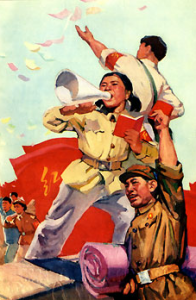
Images of the Cultural Revolution and of Mao
Artifact
Publisher: Long Bow Group
urls: http://www.morningsun.org/images/index.html# (www.morningsun.org/images/image.swf)
The Red Guard uniform became exceedingly popular at the start of the Proletarian Revolution in 1966. As a result of the Great Leap Forward of the 1950s, (the GLF and the CR are two different historical events) mass groups of Chinese people participated in “the backyard furnace” in order to catch up to the production in the Western world. With tension between parties, the Sino-Soviet split, and his anger for the differences in social classes, Mao was able to rise and mobilize students and young adults throughout China to serve as “Red Guards,” the agents of the revolution. The above image represents dominant factors in the Mao era: youth, uniformity, and political correctness. make a statement rather list of phrases
When looking at this image, the viewer is able to locate many of its important attributes and aspects that prove to be very symbolic to the time period. There are three main people in this photo, however, our eyes are drawn to the middle figure in the center who appears to be a young woman. All people are holding the red book, are wearing the grass-green Red Guard uniform or white uniform. The woman in the center is yelling passionately into a megaphone. The dominating color in this image is red.
In his article, “Uniform Rebellion, Fabricated Identity,” LiLi explains, “it is from the images of the Chinese girls wearing timeless PLA uniforms and ever-changing appearances that the artist attempts to discover the connections between history of Chinese revolutions and contemporary kitschy culture”(464). It is interesting to see that the artist chose to insert a young woman as the focal point in this image. She is passionately screaming into the megaphone and has a very determined and zealous look on her face. She appears to be young, full of energy, and passionate for her cause. This female depiction differs significantly to the post- Mao era art pieces, where females are portrayed as more “skeptical”(461). Although there were different variations of the uniform, the symbolism associated with it became a uniting factor in the young generation. The artist is emphasizing the importance of age at this time and the dominating role that the youth played. stay with the claim of “young woman as the focal point” and explain why so?
Mao promoted rebellion and militants. The men and women pictured are dressed in the Red Guard uniform and show determination and pride. By wearing this uniform, one showed his power, fashion, and political correctness. In addition, the artist displays both men and a woman wearing the uniform to show its gender neutrality (if this is the focal point, then introduce it as a topic sentence and explain with visual denotations). Men and women alike felt empowered and were able to unite and become a collective and active group; they invested their time in something bigger than themselves. The man on the bottom left is holding up the red book. Through this action, he is asserting his dedication and belief in Mao as a leader. The woman in the center is actively reading the book and preaching Mao’s ideology.
yes, color red and its connotations, need a topic sentence? The dominant color in this photo is red. The artist’s decision to emphasize this color works in unison to its importance at the time. The red color symbolizes… and devotion to Mao. In addition, we can see the traditional grass-green colored uniform. The other color featured is white, which represents political correctness and high social status.
Overall, the Red Guard Uniform represented uniformity and political correctness. It was also the uniform that the youth wore to assert their power and feel part of something bigger than themselves.
work on paragraph organization
